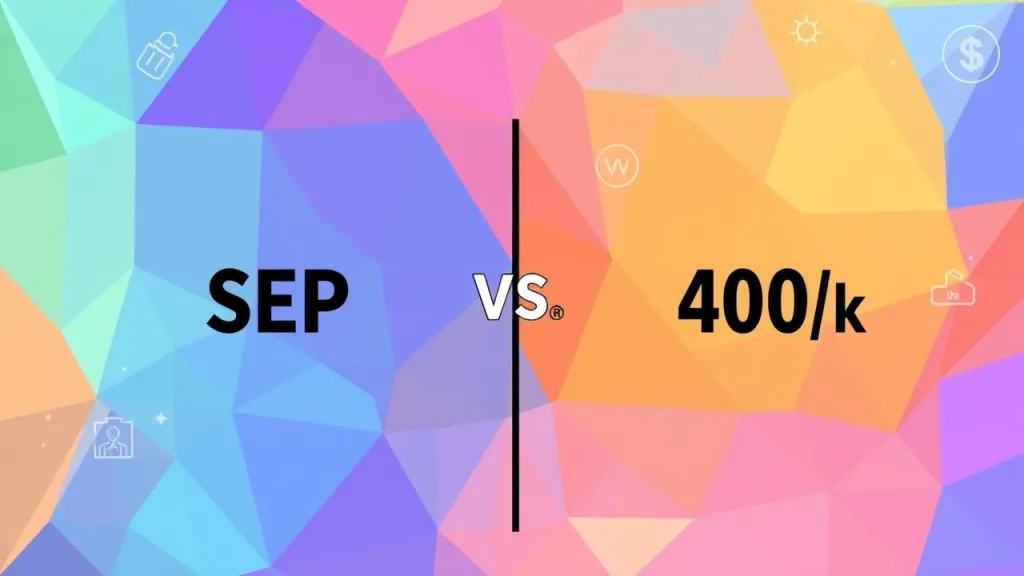The Definitive Guide to SEP IRAs vs. Solo 401(k)s for Freelancer Retirement
As a freelancer, you’re your own boss, your own HR department, and crucially, your own retirement planner. The freedom to set your own hours and choose your projects is invaluable, but it also means taking charge of your long-term financial security. When it comes to retirement savings, two powerful vehicles stand out for self-employed individuals and small business owners: the SEP IRA and the Solo 401(k).
But which is right for you? The choice can significantly impact how much you can save and how your savings grow. This definitive guide breaks down the core differences between SEP IRAs and Solo 401(k)s, helping US freelancers make an informed decision for a secure retirement. While UK freelancers have different pension systems, this guide focuses on the US retirement landscape for the self-employed.
FreelanceFin’s Opinion: Planning for retirement early is one of the smartest financial moves a freelancer can make. Understanding your retirement account options is the first step to building a nest egg that supports your future freedom.
Understanding Your Freelancer Retirement Options
Both SEP IRAs and Solo 401(k)s allow you to contribute a significant portion of your self-employment income, offering substantial tax advantages. They are designed for individuals who work for themselves and have no full-time employees (other than a spouse).
What is a SEP IRA (Simplified Employee Pension)?
A SEP IRA is a retirement plan that allows employers to contribute to their own and their employees’ IRAs. For freelancers, it’s a straightforward way to save for retirement with high contribution limits.
Key Features:
- Simplicity: Easy to set up and administer.
- High Contribution Limits: You can contribute up to 25% of your net adjusted self-employment income, or $69,000 (for 2024), whichever is less.
- Flexibility: Contributions are discretionary; you can vary the amount you contribute year to year.
- Employer Contributions Only: Only the ’employer’ (you) can contribute. There’s no employee contribution component.
What is a Solo 401(k)?
A Solo 401(k) (also known as an individual 401(k) or uni-k) is a retirement savings plan for business owners with no employees (or only a spouse). It combines features of a traditional 401(k) for employees with an employer profit-sharing plan.
Key Features:
- Dual Contribution Streams: You can contribute as both an employee and an employer, allowing for potentially higher contributions than a SEP IRA in some scenarios.
- Higher Potential Contributions: As an employee, you can contribute up to $23,000 (for 2024), plus an additional $7,500 if you’re age 50 or older. As an employer, you can contribute up to 25% of your net adjusted self-employment income. The total contribution limit is the lesser of $69,000 (for 2024) or 100% of your compensation.
- Roth Option: Many Solo 401(k)s offer a Roth (after-tax) contribution option for the employee portion, allowing for tax-free growth and withdrawals in retirement.
- Loan Feature: Some Solo 401(k) plans allow you to borrow from your retirement funds, though this should be done cautiously.
- More Complex Administration: Can be slightly more complex to set up and administer, especially if assets exceed $250,000 (requiring annual Form 5500-EZ filing).
SEP IRA vs. Solo 401(k): A Direct Comparison
Let’s break down the key differences to help you decide:
Contribution Limits: Who Contributes More?
This is often the deciding factor. The total amount you can contribute depends on your net adjusted self-employment income. Here’s how they stack up:
- SEP IRA: Maximum is 25% of your net adjusted self-employment income, capped at $69,000 (for 2024).
- Solo 401(k): Offers a dual contribution. The ’employee’ contribution is a flat dollar amount ($23,000 in 2024, or $30,500 if age 50+). The ’employer’ contribution is 25% of your net adjusted self-employment income. The total cannot exceed $69,000 (for 2024).
Scenario 1: Lower Income Freelancers (e.g., $50,000 net income)
- SEP IRA: 25% of $50,000 = $12,500
- Solo 401(k): $23,000 (employee) + 25% of $50,000 (employer, calculated on net adjusted SE income, which is typically business income minus half of SE tax) = roughly $23,000 + $11,000 = $34,000 (This calculation requires careful attention to the definition of net adjusted SE income). The Solo 401(k) allows for much higher contributions at this income level due to the employee contribution.
Scenario 2: Higher Income Freelancers (e.g., $200,000 net income)
- SEP IRA: 25% of $200,000 = $50,000
- Solo 401(k): $23,000 (employee) + 25% of $200,000 (employer) = $23,000 + $50,000 = $73,000. However, the total contribution is capped at $69,000 for 2024. So, the Solo 401(k) contribution would be $69,000.
As you can see, for higher incomes, the total maximum contribution limit is the same, but the *way* you get there differs. The Solo 401(k) offers more flexibility in how those contributions are allocated between employee and employer.
Administration and Complexity
SEP IRA: Generally simpler. Fewer administrative requirements, no annual filing needed unless you have employees. Contributions are typically made as a lump sum or in a few installments. You can usually set one up anytime up to your tax filing deadline (including extensions).
Solo 401(k): Can be slightly more complex. You need to establish the plan by December 31st of the tax year for which you want to make contributions. If your plan assets exceed $250,000, you must file Form 5500-EZ annually. Employer contributions are due by your tax filing deadline, but employee contributions can be made up until your tax filing deadline.
Roth Contribution Option
SEP IRA: All contributions are pre-tax, meaning they reduce your current taxable income. Withdrawals in retirement are taxed as ordinary income.
Solo 401(k): Many plans offer a Roth (after-tax) contribution option for the employee portion. This means you pay taxes on that portion now, but qualified withdrawals in retirement are tax-free. This can be highly advantageous if you expect to be in a higher tax bracket in retirement.
Catch-Up Contributions
SEP IRA: No specific catch-up contributions are allowed for those over 50. You contribute based on the standard percentage of your income, capped at the overall limit.
Solo 401(k): Allows for “catch-up” contributions for individuals aged 50 and over. In 2024, you can contribute an additional $7,500 as an employee, bringing your total employee contribution to $30,500.
Loan Provisions
SEP IRA: You cannot borrow from a SEP IRA.
Solo 401(k): Many Solo 401(k) plans allow participants to borrow up to 50% of their vested account balance, or $50,000, whichever is less. While this offers liquidity, it comes with risks and needs careful consideration.
When to Choose Which Plan
Choose a SEP IRA if:
- You prioritize simplicity and ease of administration.
- You want to contribute a flat percentage of your income without worrying about employee vs. employer allocations.
- You need the flexibility to decide each year how much to contribute.
- You are setting up your plan close to the tax filing deadline.
Choose a Solo 401(k) if:
- You are under age 50 and want to maximize your contributions at lower to moderate income levels due to the employee contribution option.
- You are age 50 or older and want to take advantage of catch-up contributions.
- You want the option for Roth (after-tax) contributions for tax-free withdrawals in retirement.
- You value the potential loan feature (use with caution).
How to Calculate Your Contribution Limits
Calculating your exact contribution is crucial and can be complex for self-employed individuals. It involves your net adjusted self-employment income, which is generally calculated as your gross business income minus your business expenses, and then further reduced by half of your self-employment taxes.
Example Calculation (Simplified):
Let’s say you have $60,000 in net adjusted self-employment income.
- SEP IRA: You can contribute up to 25% of $60,000, which is $15,000.
- Solo 401(k):
- Employee contribution: $23,000 (assuming under age 50)
- Employer contribution: 25% of $60,000 = $15,000
- Total potential: $23,000 + $15,000 = $38,000
- However, the total cannot exceed $69,000 (for 2024), and also cannot exceed 100% of your compensation. In this example, the maximum you could contribute to the Solo 401(k) would be $38,000.
Important Note: The actual calculation of your contribution limit involves specific IRS formulas. It’s highly recommended to use an online calculator or consult a tax professional to determine your exact figures.
Setting Up Your Plan
Once you’ve decided, the next step is to open an account. You can typically do this through most major brokerage firms (e.g., Fidelity, Vanguard, Charles Schwab) or specialized retirement plan providers.
- For SEP IRAs: You can often open one online with your brokerage.
- For Solo 401(k)s: You’ll need to find a provider that offers Solo 401(k) plans. Some brokerages offer them, while others specialize in them.
You’ll need to provide your Social Security number, business information, and other details. Be sure to understand the plan’s specific rules, fees, and investment options.
External Link Example: For comprehensive retirement planning resources, the US Department of Labor offers guidance on retirement plans.
Conclusion
Choosing between a SEP IRA and a Solo 401(k) is a critical decision for any freelancer serious about their retirement. While the SEP IRA offers simplicity, the Solo 401(k) often provides greater contribution potential, especially at lower to moderate income levels, and offers valuable features like Roth contributions and loan options.
Consider your current income, future earning potential, desire for administrative ease, and long-term retirement goals. Consulting with a tax advisor or financial planner can provide personalized guidance to ensure you make the best choice for your financial future.
FreelanceFin’s Opinion: Don’t let the details of retirement accounts overwhelm you. By taking the time to understand these options, you’re investing in your future self and securing the financial independence you’ve worked so hard to achieve. What are your biggest questions about freelance retirement savings? Share them below!
Frequently Asked Questions (FAQs)
No, you generally cannot contribute to both a SEP IRA and a Solo 401(k) in the same year. You must choose one plan to contribute to for your self-employment income.
For a SEP IRA, you can typically open and contribute until your tax filing deadline, including extensions. For a Solo 401(k), the plan must be established by December 31st of the tax year for contributions to be made for that year. Contributions themselves can often be made up until the tax filing deadline.
Yes, having a SEP IRA does not prevent you from contributing to a traditional IRA, as long as you meet the income limitations for deducting traditional IRA contributions.
Yes, if your Solo 401(k) plan assets exceed $250,000, you are generally required to file Form 5500-EZ annually with the IRS. SEP IRAs do not have this specific reporting requirement unless you have employees.
For freelancers with no employees, both are excellent options. The Solo 401(k) generally allows for higher contributions at lower income levels and offers Roth options. A SEP IRA is simpler to administer. The best choice depends on your specific income and financial goals.
References and Further Reading
- IRS.gov: SEP IRA Overview.
- IRS.gov: Individual 401(k).
- Vanguard: SEP IRA for Small Businesses.
- Fidelity: Individual 401(k) for Small Business Owners.
- Charles Schwab: Solo 401(k) vs. SEP IRA.
- NerdWallet: SEP IRA vs. Solo 401(k).




